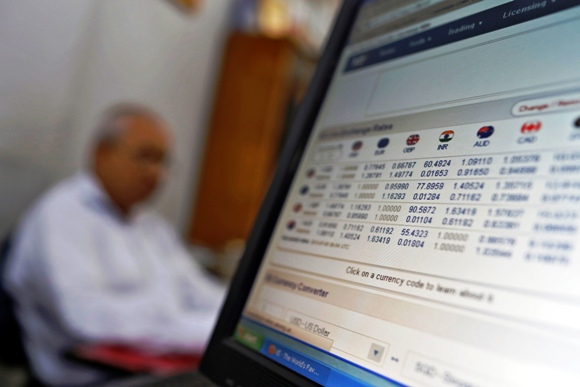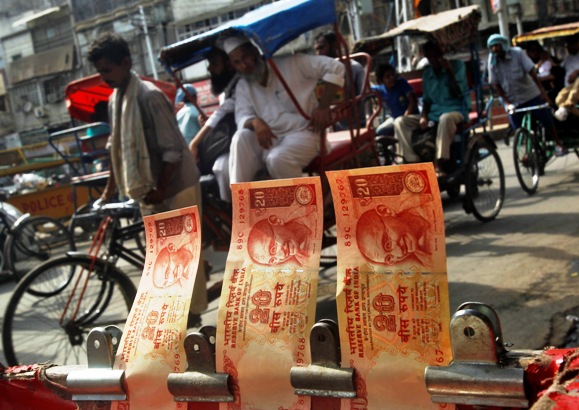Photographs: Reuters Suvashree Dey Choudhury in Mumbai
With only enough cash in the Reserve Bank of India to pay for seven months of imports, $172 billion of debt falling due in the next eight months and weak fund inflows, the balance of payments position is undermining its ability to defend a tumbling rupee.
A heavy dependence on imported energy, gold and technology means India has historically run a current account deficit, which it has funded by attracting foreign money into stocks, bonds and corporate investment.
But as global investors turn away from emerging markets in anticipation of the US Federal Reserve starting to wind back its stimulus, India's weak external position makes it more vulnerable to outflows and a balance of payments deficit.
India has $280 billion of foreign exchange reserves.
That is only enough to cover seven months of import bills, by far the lowest of the Brazil, Russia, India, China and South Africa (BRICS), the major emerging market economies.
. . .
How balance of payment woes are hurting rupee rescue
Image: A private money trader counts Indian Rupee currency notes at a shop in Mumbai.Photographs: Vivek Prakash/Reuters
That has left the RBI with limited firepower to support a rupee which has fallen 12 percent since the start of May and hit a record low of 61.80 to the dollar last week.
India ‘can't afford to defend the currency much with such little reserves,’ a policymaker said, declining to be identified as he was not authorised to speak with media.
The RBI is said to consider three months of import cover to be the minimum acceptable level, but some central bank insiders are said to be uncomfortable that reserves have run down to the lowest in terms of import cover since 1996.
"The lower import cover continues to be a source of discomfort," said another policymaker.
"We would like to increase the import cover. If there is a gap in the BOP, then the currency will have to take a hit."
That said, India is not yet looking at a repeat of its 1991 crisis.
Then, with only enough reserves to cover three weeks of imports, the government was forced to pledge its gold in order to pay its bills and had to push through reforms to start opening up the economy.
. . .
How balance of payment woes are hurting rupee rescue
Image: A man sits next to a computer screen showing the Indian rupee currency rates inside a private money exchange office in New Delhi.Photographs: Adnan Abidi/Reuters
VULNERABLE
In the fiscal year that started in April, stocks have attracted a net $2.3 billion in inflows, but if that changes India could find itself with a balance of payments deficit.
Debt has seen a net outflow of about $5.7 billion.
Stocks account for a whopping $220 billion of foreign holdings in India, according to Bank of America-Merrill Lynch. Debt makes up a comparatively small $81 billion in foreign assets, government data shows.
India ran balanceofpayments deficits in 2008/09 and 2011/12.
It posted a small surplus of $3.8 billion in the 2012/13 year that ended in March, but some economists expect it to slip back into deficit this fiscal year.
All up by the end of this fiscal year, India needs to refinance or repay $172 billion of liabilities -- such as foreign borrowings, trade credit, and private debts -- which is almost 45 per cent of its overall external borrowings and equivalent to 59 percent of its reserves.
"We are vulnerable now," said Abheek Barua, chief economist at HDFC Bank in New Delhi.
. . .
How balance of payment woes are hurting rupee rescue
Image: Cycle rickshaws move past a display of Indian rupees at a roadside currency exchange stall in the old quarters of Delhi.Photographs: Anindito Mukherjee/Reuters
"If this vulnerability manifests into one large default on domestic loans or external commercial borrowings, it could threaten a sovereign rating downgrade and that could trigger a balance of payments crisis," Barua said.
Any corporate default is seen as more likely to be on domestic debt, but the risk is it would spoil the broader investment environment and hit already-slowing economic growth.
Investors are hoping the appointment Raghuram Rajan, a former chief economist of the International Monetray Fund, as Reserve Bank of India Governor from September helps accelerate measures to stabilise the rupee.
Rajan has spoken of a sovereign or quasi-sovereign bond issue to attract dollar inflows, widely seen as an effective if costly stop-gap measure to support the rupee.
Outgoing Governor Duvvuri Subbarao has spoken against issuing sovereign bonds.
. . .
How balance of payment woes are hurting rupee rescue
Image: A man walks past a board advertising US dollars at a money exchange shop in Colombo.Photographs: Dinuka Liyanawatte/Reuters
CURRENT ACCOUNT DEFICIT
While the government has put curbs gold imports and taken other measures to narrow the gap on external accounts, investors and economists believe much more is needed to attract long-term funds to help balance the external accounts.
The current account is in persistent deficit -- there was a shortfall of $88 billion, or a record 4.8 per cent of gross domestic product in 2012/13 -- but there are limits to what can be done to lower it.
The bill for oil, the largest and most inelastic of India’s imports, was $169.4 billion in 2012/13, and a weaker rupee will only push up the cost further.
HDFC Bank's Barua expects India to end up with a balanceof payment deficit of $12 billion to $15 billion in 2013/14.
"We are not close to the crisis situation seen in 1991, but it cannot be ruled out of a realm of possibility," he said.







article